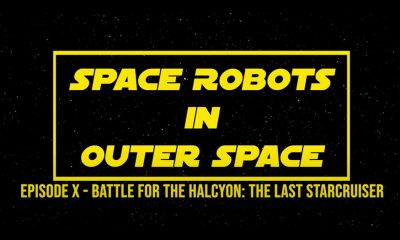
Annoyed in Anaheim writes in to say:
I have to say that I was very disappointed with the Disney
Parks & Resorts presentation at the D23 EXPO. They didn’t announce anything
significant for Walt Disney World. You’d think, given that it’s been almost a
quarter of a century since a new country was last added to the World Showcase,
that they could have at least announced a new international pavilion for Epcot.
Dear Annoyed in Anaheim,
Ah, but just because they announced a new country for Epcot’s
World Showcase area doesn’t mean that Disney will actually ever get around to
building it.
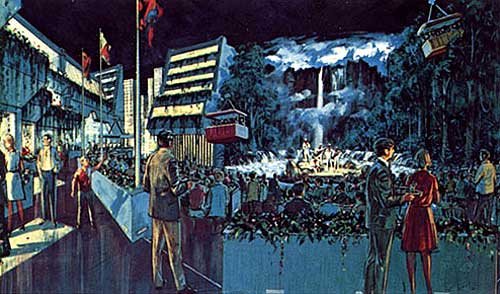 Concept art for the interior of World Showcase’s proposed Venezuela pavilion.
Concept art for the interior of World Showcase’s proposed Venezuela pavilion.
Copyright Disney Enterprises, Inc. All rights reserved
Don’t believe me? Then check out this official press releasethat Walt Disney World officials issued on November 10, 1981, which reveals that …
… Venezuela has become the fifth South American country to
join the community of nations in WDW Epcot Center with the signing of a Contract
for Design of a Venezuelan pavilion for Phase II of the World Showcase.
The World Showcase is part of Epcot Center, a showplace for today’s
nations and tomorrow’s technology. Epcot Center will open October 1, 1982 and
will cost $800 million. Gustavo J. Vollmer, Chairman of Consorio Inversionista
Mercantil J Agricola (CIMA) in Caracas and Card Walker, Chairman of the Board
and Chief Executive of Walt Disney Productions signed the preliminary
participation agreement at Walt Disney World.
The Venezuelan pavilion joins a number of countries and
areas of the world scheduled for addition to the eight inaugural World Showcase
nations. They include: Mexico, China, Germany, Italy, Japan, France, the United
Kingdom and Canada. Venezuela, the State of Israel and Equatorial Africa are
among the Phase II pavilions planned.
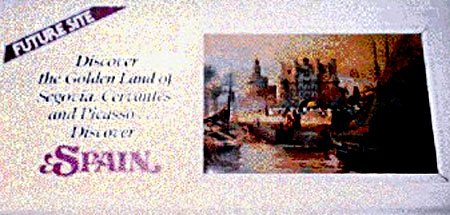 Photograph of the sign that was in place for Epcot’s opening day on October 1,
Photograph of the sign that was in place for Epcot’s opening day on October 1,
1982, designating where World Showcase’s Spain pavilion was going to be
built. Copyright Disney Enterprises, Inc. All rights reserved
Better yet, how about this press release from December ofthat same year. When Disney World proudly announced that …
Spain (has joined) the growing list of countries in the
community of nations at Epcot Center with the signing of a contract for the
design of a Spain pavilion for Phase II of World Showcase.
D. Aurlio Torrente LaRosa, director of ECCE (Exposiciones
Congresos y Convencione & Espana), on behalf of the Ministry of
Transportation, Tourism and Communications for Spain, and Dick Nunis, president
of Walt Disney World Co. signed the preliminary design agreement.
Nunis also met with King Juan Carlos and Queen Dona Sofia at
the Royal Palace to discuss the scope of the Epcot Center project and Spain’s
participation.
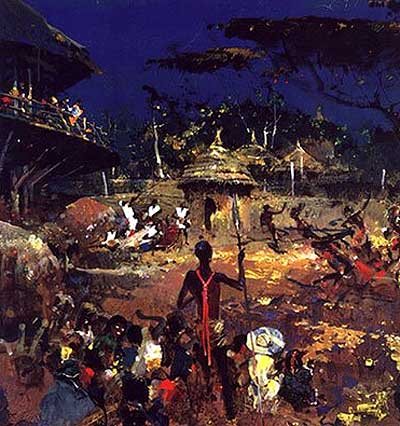
Herbie Ryman’s concept art for World Showcase’s Equatorial Africa
pavilion.
Copyright Disney Enterprises, Inc. All rights reserved
Spain joins Venezuela, the State of Israel, and Equatorial
Africa in the Phase II development of World Showcase.
“So why didn’t these Venezuela or Spain pavilions ever get
added to Epcot’s World Showcase area?,” you ask. Well, as Steve Baker (who – atthat time – was director of participant affairs for the Walt Disney World
Resort) told Vicki Vaughn of the Orlando Sentinel in an October 1984 interview:
Efforts to sign on Spain has been tougher. When Baker went to Spain for the
first time in 1981, he succeeded in getting the government to pay for the
design of that country’s pavilion. (He declined to reveal the design costs of individual
pavilions, but he said on average cost about $500,000.) But a new, young
government took over in Spain. “When we came back to talk, we realized that we
had no friends,” Baker said. “So consequently, we had to start over.”
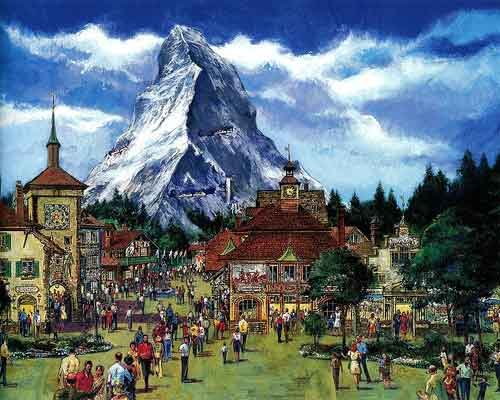
Copyright Disney Enterprises, Inc. All rights reserved
This sort of thing happened over & over again when it
came to luring new nations to come be part of Epcot’s World Showcase area. Take
– for example – the proposed Swiss pavilion (which was to have been the home of
an East Coast version of Disneyland’s very first thrill ride, the Matterhorn
Bobsleds). Disney started negotiations with Swiss officials in 1986, only to
then have these talks broken off in 1987. While these negotiations would eventually
resume in 1989, Mouse House officials were never able to find a Swiss
corporation that was then willing to underwrite the initial construction costs as
well as supply the funds necessary to operate & maintain an attraction of this
size.
“And why were these companies & countries so reluctant
to commit to World Showcase?,” you query. Well, sometimes it was the terms of
the deal (Disney tended to try & get corporations to sign long-term
sponsorship deals when it came to rides, shows and attractions for the Parks.
Take – for example – the 13-year lease that the Mouse got United Technologies
to sign, for the Living Seas pavilion). And sometimes it was the possible
penalties that were involved should a country or company renege on its previous
agreement to sponsor a World Showcase pavilion (EX: The May 1989 lawsuit that the Walt Disney Company
brought against Eskantorp. Which – in December of 1985 — entered into a
preliminary agreement with the Mouse to serve as the principal developer & sponsor
of a South American pavilion. Only to then not be able to come up with the cash
necessary to underwrite the design & construction of this proposed World
Showcase addition).
Of course, sometimes it was just a case of initially
promising negotiations just petering out. Take – for example – the Russia
pavilion. Which was once considered to be a very strong candidate for World
Showcase’s Phase II. Dick Nunis (the then-Chairmain of Walt Disney Parks &
Resorts) personally met with a Russian delegation in November of 1988 and –
after this meeting – sounded very optimistic about this pavilion eventually being
added to Epcot. That said, even though Nunis told the Orlando Sentinel that ” …
the timing is very, very good to have negotiations with the Soviet Union,”
nothing came out of these talks.
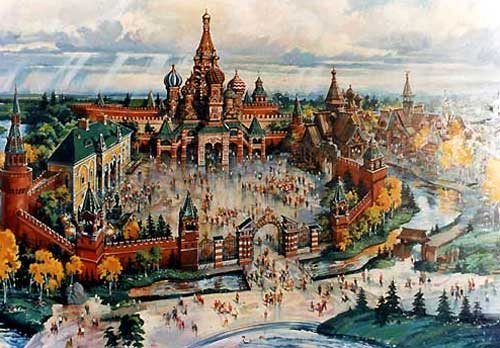 Copyright Disney Enterprises, Inc. All rights reserved
Copyright Disney Enterprises, Inc. All rights reserved
The same sort of thing happened in April 1979, when Walt
Disney Productions officials received a Letter of Intent from Kenyan officials.
Which said that Kenya – along with the nations of Senegal and the Ivory Coast –
had agreed in principal to sponsor World Showcase’s Africa pavilion. But then
this trio of African countries began squabbling about which nation would
receive top billing on the entrance to this sure-to-be Epcot showplace. And
this sponsorship deal quickly fell apart.
Perhaps the saddest story associated with World Showcase’s
proposed Phase II is the one concerning the Israel pavilion. In November 1980,
the State of Israel actually signed a deal to officially become part of Epcot. Joseph
Wollf, special officer to the Minister of Finance and president of the Tourist
Industry Development Corporation signed an agreement that called for this
Middle Eastern country to underwrite the design & construction of a World
Showcase pavilion that was estimated to cost $30 – $35 million. What’s more, Jeshaja
Weinberg (i.e. director of the Jewish Museum in Tel Aviv) agreed to provide
Disney with a wide variety of archaeological artifacts. Which could then be put
on display in a rotating gallery that was to have been part of Epcot’s Israel
pavilion.
“So if the money and the artifacts were already in place,
why didn’t this proposed World Showcase pavilion ever get built?,” you ask.
Well, that’s where things get kind of vague. Though there were signs in place
on Epcot’s opening day trumpeting that the Israel pavilion was “Coming Soon,”
by October 1984, there was no sign of this previously-announced World Showcase
addition.
Steve Baker (while speaking with Vicki Vaughn of the Orlando
Sentinel) tried to put the best possible face on the situation. Insisting that
The Walt Disney Company had …
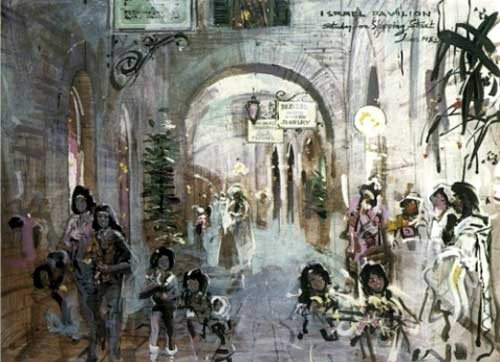 Herbie Ryman’s concept art for the shopping district that was to have been built as part
Herbie Ryman’s concept art for the shopping district that was to have been built as part
of the World Showcase’s Israel pavilion. Copyright Disney Enterprises, Inc.
All rights reserved
… made much progress towards an Israel pavilion, getting the
Israeli government to contribute design money and enlisting its help in putting
together private sectors funds, Baker said. But “all this has taken five years
and we expect lots of changes to occur” before the Israel pavilion takes shape.
To date, World Showcase’s Israel pavilion has never made it
off the drawing board. Reportedly because many senior Disney Company officials
believe that including Israel as part of Epcot would then turn this theme park
into a possible target for terrorism. Or – at the very least – a potential
protest focal point. Which actually did prove to be the case when – in 1999 – the
Arab League pushed for a boycott of the Millennium Village at Epcot due to the inclusion
of an Israel Pavilion as part of this 15-month-long celebration.
Trust me, folks. This is just the tip of the iceberg when it
comes to stories associated with the proposed Phase II of World Showcase area.Which – at one point – was to have included Epcot’s first Eastern European
country, Poland.
Better yet, remind me sometime to talk about the early,
early days of Disney’s World Showcase. We’re talking 1975 – 1977 here. When theMouse reached out to representatives of 31 separate countries to ask them to
become part of Epcot … Only to then have each of these countries then say “No.”
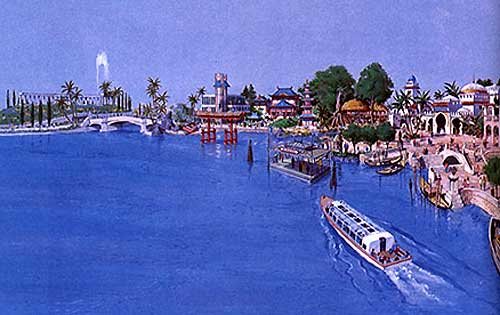 An early concept painting of Epcot’s World Showcase. Back when this part of that
An early concept painting of Epcot’s World Showcase. Back when this part of that
futuristic theme park was supposed to be home to 17 international pavilions.
Copyright Disney Enterprises, Inc. All rights reserved
Seriously. Even the United Kingdom (which was one of the
United States’ closest allies) refused to take part in the project. Reportedly
because they just couldn’t seen the benefit of being part of Disney’s
futuristic theme park. Which is why the Imagineers then quietly revised their
plans for World Showcase. First scaling back the proposed line-up for this
theme park from 31 international pavilions to 17. Then making further cuts,
dropping from 17 to just 8 – 10 countries. And at one point, Disney officials
were having so much trouble lining up World Showcase participants that they
supposedly told Wall Street insiders that – on Epcot’s opening day – this theme
park might only have 5 international pavilions.
But that’s a story for another time. Speaking of which … If
you’d like to see one of your Disney-related questions answered as part of afuture Why For column, please send your queries along to whyfor@jimhillmedia.com
.
That’s it for now, folks. And if you live on the East Coast,here’s hoping that Hurricane Irene doesn’t give you too much trouble this weekend.
Talk to you later, okay?

History
The Evolution and History of Mickey’s ToonTown

Disneyland in Anaheim, California, holds a special place in the hearts of Disney fans worldwide, I mean heck, it’s where the magic began after all. Over the years it’s become a place that people visit in search of memorable experiences. One fan favorite area of the park is Mickey’s Toontown, a unique land that lets guests step right into the colorful, “Toony” world of Disney animation. With the recent reimagining of the land and the introduction of Micky and Minnies Runaway Railway, have you ever wondered how this land came to be?
There is a fascinating backstory of how Mickey’s Toontown came into existence. It’s a tale of strategic vision, the influence of Disney executives, and a commitment to meeting the needs of Disney’s valued guests.
The Beginning: Mickey’s Birthdayland
The story of Mickey’s Toontown starts with Mickey’s Birthdayland at Walt Disney World’s Magic Kingdom. Opened in 1988 to celebrate Mickey Mouse’s 60th birthday, this temporary attraction was met with such overwhelming popularity that it inspired Disney executives to think bigger. The idea was to create a permanent, immersive land where guests could step into the animated world of Mickey Mouse and his friends.
In the early ’90s, Disneyland was in need of a refresh. Michael Eisner, the visionary leader of The Walt Disney Company at the time, had an audacious idea: create a brand-new land in Disneyland that would celebrate Disney characters in a whole new way. This was the birth of Mickey’s Toontown.
Initially, Disney’s creative minds toyed with various concepts, including the idea of crafting a 100-Acre Woods or a land inspired by the Muppets. However, the turning point came when they considered the success of “Who Framed Roger Rabbit.” This film’s popularity and the desire to capitalize on contemporary trends set the stage for Toontown’s creation.
From Concept to Reality: The Birth of Toontown
In 1993, Mickey’s Toontown opened its gates at Disneyland, marking the first time in Disney Park history where guests could experience a fully realized, three-dimensional world of animation. This new land was not just a collection of attractions but a living, breathing community where Disney characters “lived,” worked, and played.
Building Challenges: Innovative Solutions
The design of Mickey’s Toontown broke new ground in theme park aesthetics. Imagineers were tasked with bringing the two-dimensional world of cartoons into a three-dimensional space. This led to the creation of over 2000 custom-built props and structures that embodied the ‘squash and stretch’ principle of animation, giving Toontown its distinctiveness.
And then there was also the challenge of hiding the Team Disney Anaheim building, which bore a striking resemblance to a giant hotdog. The Imagineers had to think creatively, using balloon tests and imaginative landscaping to seamlessly integrate Toontown into the larger park.

Key Attractions: Bringing Animation to Life
Mickey’s Toontown featured several groundbreaking attractions. “Roger Rabbit’s Car Toon Spin,” inspired by the movie “Who Framed Roger Rabbit,” became a staple of Toontown, offering an innovative ride experience. Gadget’s Go-Coaster, though initially conceived as a Rescue Rangers-themed ride, became a hit with younger visitors, proving that innovative design could create memorable experiences for all ages.
Another crown jewel of Toontown is Mickey’s House, a walkthrough attraction that allowed guests to explore the home of Mickey Mouse himself. This attraction was more than just a house; it was a carefully crafted piece of Disney lore. The house was designed in the American Craftsman style, reflecting the era when Mickey would have theoretically purchased his first home in Hollywood. The attention to detail was meticulous, with over 2000 hand-crafted, custom-built props, ensuring that every corner of the house was brimming with character and charm. Interestingly, the design of Mickey’s House was inspired by a real home in Wichita Falls, making it a unique blend of real-world inspiration and Disney magic.
Mickey’s House also showcased Disney’s commitment to creating interactive and engaging experiences. Guests could make themselves at home, sitting in Mickey’s chair, listening to the radio, and exploring the many mementos and references to Mickey’s animated adventures throughout the years. This approach to attraction design – where storytelling and interactivity merged seamlessly – was a defining characteristic of ToonTown’s success.

Executive Decisions: Shaping ToonTown’s Unique Attractions
The development of Mickey’s Toontown wasn’t just about creative imagination; it was significantly influenced by strategic decisions from Disney executives. One notable input came from Jeffrey Katzenberg, who suggested incorporating a Rescue Rangers-themed ride. This idea was a reflection of the broader Disney strategy to integrate popular contemporary characters and themes into the park, ensuring that the attractions remained relevant and engaging for visitors.
In addition to Katzenberg’s influence, Frank Wells, the then-President of The Walt Disney Company, played a key role in the strategic launch of Toontown’s attractions. His decision to delay the opening of “Roger Rabbit’s Car Toon Spin” until a year after Toontown’s debut was a calculated move. It was designed to maintain public interest in the park by offering new experiences over time, thereby giving guests more reasons to return to Disneyland.
These executive decisions highlight the careful planning and foresight that went into making Toontown a dynamic and continuously appealing part of Disneyland. By integrating current trends and strategically planning the rollout of attractions, Disney executives ensured that Toontown would not only capture the hearts of visitors upon its opening but would continue to draw them back for new experiences in the years to follow.
Global Influence: Toontown’s Worldwide Appeal
The concept of Mickey’s Toontown resonated so strongly that it was replicated at Tokyo Disneyland and influenced elements in Disneyland Paris and Hong Kong Disneyland. Each park’s version of Toontown maintained the core essence of the original while adapting to its cultural and logistical environment.
Evolution and Reimagining: Toontown Today
As we approach the present day, Mickey’s Toontown has recently undergone a significant reimagining to welcome “Mickey & Minnie’s Runaway Railway” in 2023. This refurbishment aimed to enhance the land’s interactivity and appeal to a new generation of Disney fans, all while retaining the charm that has made ToonTown a beloved destination for nearly three decades.

Dive Deeper into ToonTown’s Story
Want to know more about Mickey’s Toontown and hear some fascinating behind-the-scenes stories, then check out the latest episode of Disney Unpacked on Patreon @JimHillMedia. In this episode, the main Imagineer who worked on the Toontown project shares lots of interesting stories and details that you can’t find anywhere else. It’s full of great information and fun facts, so be sure to give it a listen!
History
Unpacking the History of the Pixar Place Hotel

Pixar Place Hotel, the newly unveiled 15-story tower at the Disneyland Resort, has been making waves in the Disney community. With its unique Pixar-themed design, it promises to be a favorite among visitors.
However, before we delve into this exciting addition to the Disneyland Resort, let’s take a look at the fascinating history of this remarkable hotel.
The Emergence of the Disneyland Hotel
To truly appreciate the story of the Pixar Place Hotel, we must turn back the clock to the early days of Disneyland. While Walt Disney had the visionary ideas and funding to create the iconic theme park, he faced a challenge when it came to providing accommodations for the park’s visitors. This is where his friend Jack Wrather enters the picture.
Jack Wrather, a fellow pioneer in the television industry, stepped in to assist Walt Disney in realizing his dream. Thanks to the success of the “Lassie” TV show produced by Wrather’s company, he had the financial means to build a hotel right across from Disneyland.
The result was the Disneyland Hotel, which opened its doors in October 1955. Interestingly, the early incarnation of this hotel had more of a motel feel than a hotel, with two-story buildings reminiscent of the roadside motels popular during the 1950s. The initial Disneyland Hotel consisted of modest structures that catered to visitors looking for affordable lodging close to the park. While the rooms were basic, it marked the beginning of something extraordinary.
The Evolution: From Emerald of Anaheim to Paradise Pier
As Disneyland’s popularity continued to soar, so did the demand for expansion and improved accommodations. In 1962, the addition of an 11-story tower transformed the Disneyland Hotel, marking a significant transition from a motel to a full-fledged hotel.
The addition of the 11-story tower elevated the Disneyland Hotel into a more prominent presence on the Anaheim skyline. At the time, it was the tallest structure in all of Orange County. The hotel’s prime location across from Disneyland made it an ideal choice for visitors. With the introduction of the monorail linking the park and the hotel, accessibility became even more convenient. Unique features like the Japanese-themed reflecting pools added to the hotel’s charm, reflecting a cultural influence that extended beyond Disney’s borders.
Japanese Tourism and Its Impact
During the 1960s and 1970s, Disneyland was attracting visitors from all corners of the world, including Japan. A significant number of Japanese tourists flocked to Anaheim to experience Walt Disney’s creation. To cater to this growing market, it wasn’t just the Disneyland Hotel that aimed to capture the attention of Japanese tourists. The Japanese Village in Buena Park, inspired by a similar attraction in Nara, Japan, was another significant spot.
These attractions sought to provide a taste of Japanese culture and hospitality, showcasing elements like tea ceremonies and beautiful ponds with rare carp and black swans. However, the Japanese Village closed its doors in 1975, likely due to the highly competitive nature of the Southern California tourist market.
The Emergence of the Emerald of Anaheim
With the surge in Japanese tourism, an opportunity arose—the construction of the Emerald of Anaheim, later known as the Disneyland Pacific Hotel. In May 1984, this 15-story hotel opened its doors.
What made the Emerald unique was its ownership. It was built not by The Walt Disney Company or the Oriental Land Company (which operated Tokyo Disneyland) but by the Tokyu Group. This group of Japanese businessmen already had a pair of hotels in Hawaii and saw potential in Anaheim’s proximity to Disneyland. Thus, they decided to embark on this new venture, specifically designed to cater to Japanese tourists looking to experience Southern California.
Financial Challenges and a Changing Landscape
The late 1980s brought about two significant financial crises in Japan—the crash of the NIKKEI stock market and the collapse of the Japanese real estate market. These crises had far-reaching effects, causing Japanese tourists to postpone or cancel their trips to the United States. As a result, reservations at the Emerald of Anaheim dwindled.
To adapt to these challenging times, the Tokyu Group merged the Emerald brand with its Pacific hotel chain, attempting to weather the storm. However, the financial turmoil took its toll on the Emerald, and changes were imminent.
The Transition to the Disneyland Pacific Hotel
In 1995, The Walt Disney Company took a significant step by purchasing the hotel formerly known as the Emerald of Anaheim for $35 million. This acquisition marked a change in the hotel’s fortunes. With Disney now in control, the hotel underwent a name change, becoming the Disneyland Pacific Hotel.
Transformation to Paradise Pier
The next phase of transformation occurred when Disney decided to rebrand the hotel as Paradise Pier Hotel. This decision aligned with Disney’s broader vision for the Disneyland Resort.
While the structural changes were limited, the hotel underwent a significant cosmetic makeover. Its exterior was painted to complement the color scheme of Paradise Pier, and wave-shaped crenellations adorned the rooftop, creating an illusion of seaside charm. This transformation was Disney’s attempt to seamlessly integrate the hotel into the Paradise Pier theme of Disney’s California Adventure Park.
Looking Beyond Paradise Pier: The Shift to Pixar Place
In 2018, Disneyland Resort rebranded Paradise Pier as Pixar Pier, a thematic area dedicated to celebrating the beloved characters and stories from Pixar Animation Studios. As a part of this transition, it became evident that the hotel formally known as the Disneyland Pacific Hotel could no longer maintain its Paradise Pier theme.
With Pixar Pier in full swing and two successful Pixar-themed hotels (Toy Story Hotels in Shanghai Disneyland and Tokyo Disneyland), Disney decided to embark on a new venture—a hotel that would celebrate the vast world of Pixar. The result is Pixar Place Hotel, a 15-story tower that embraces the characters and stories from multiple Pixar movies and shorts. This fully Pixar-themed hotel is a first of its kind in the United States.
The Future of Pixar Place and Disneyland Resort
As we look ahead to the future, the Disneyland Resort continues to evolve. The recent news of a proposed $1.9 billion expansion as part of the Disneyland Forward project indicates that the area surrounding Pixar Place is expected to see further changes. Disneyland’s rich history and innovative spirit continue to shape its destiny.
In conclusion, the history of the Pixar Place Hotel is a testament to the ever-changing landscape of Disneyland Resort. From its humble beginnings as the Disneyland Hotel to its transformation into the fully Pixar-themed Pixar Place Hotel, this establishment has undergone several iterations. As Disneyland Resort continues to grow and adapt, we can only imagine what exciting developments lie ahead for this iconic destination.
If you want to hear more stories about the History of the Pixar Place hotel, check our special edition of Disney Unpacked over on YouTube.
Stay tuned for more updates and developments as we continue to explore the fascinating world of Disney, one story at a time.
History
From Birthday Wishes to Toontown Dreams: How Toontown Came to Be

In the latest release of Episode 4 of Disney Unpacked, Len and I return, joined as always by Disney Imagineering legend, Jim Shull . This two-part episode covers all things Mickey’s Birthday Land and how it ultimately led to the inspiration behind Disneyland’s fan-favorite land, “Toontown”. But let’s not get ahead of ourselves here. It all starts in the early days at Disneyland.
Early Challenges in Meeting Mickey
Picture this: it’s the late 1970s and early 1980s, and you’re at Disneyland. You want to meet the one and only Mickey Mouse, but there’s no clear way to make it happen. You rely on Character Guides, those daily printed sheets that point you in Mickey’s general direction. But let’s be honest, it was like finding a needle in a haystack. Sometimes, you got lucky; other times, not so much.

Mickey’s Birthdayland: A Birthday Wish that Came True
Fast forward to the late 1980s. Disney World faced a big challenge. The Disney-MGM Studios Theme Park was under construction, with the company’s marketing machine in full swing, hyping up the opening of Walt Disney World’s third theme park, MGM Studios, in the Spring of 1989. This extensive marketing meant that many people were opting to postpone their family’s next trip to Walt Disney World until the following year. Walt Disney World needed something compelling to motivate guests to visit Florida in 1988, the year before Disney MGM Studios opened.
Enter stage left, Mickey’s Birthdayland. For the first time ever, an entire land was dedicated to a single character – and not just any character, but the mouse who started it all. Meeting Mickey was no longer a game of chance; it was practically guaranteed.

The Birth of Birthdayland: Creative Brilliance Meets Practicality
In this episode, we dissect the birth of Mickey’s Birthdayland, an initiative that went beyond celebrating a birthday. It was a calculated move, driven by guest feedback and a need to address issues dating back to 1971. Imagineers faced the monumental task of designing an experience that honored Mickey while efficiently managing the crowds. This required the perfect blend of creative flair and logistical prowess – a hallmark of Disney’s approach to theme park design.
Evolution: From Birthdayland to Toontown
The success of Mickey’s Birthdayland was a real game-changer, setting the stage for the birth of Toontown – an entire land that elevated character-centric areas to monumental new heights. Toontown wasn’t merely a spot to meet characters; it was an immersive experience that brought Disney animation to life. In the episode, we explore its innovative designs, playful architecture, and how every nook and cranny tells a story.

Impact on Disney Parks and Guests
Mickey’s Birthdayland and Toontown didn’t just reshape the physical landscape of Disney parks; they transformed the very essence of the guest experience. These lands introduced groundbreaking ways for visitors to connect with their beloved characters, making their Disney vacations even more unforgettable.
Beyond Attractions: A Cultural Influence
But the influence of these lands goes beyond mere attractions. Our episode delves into how Mickey’s Birthdayland and Toontown left an indelible mark on Disney’s culture, reflecting the company’s relentless dedication to innovation and guest satisfaction. It’s a journey into how a single idea can grow into a cherished cornerstone of the Disney Park experience.

Unwrapping the Full Story of Mickey’s Birthdayland
Our two-part episode of Disney Unpacked is available for your viewing pleasure on our Patreon page. And for those seeking a quicker Disney fix, we’ve got a condensed version waiting for you on our YouTube channel . Thank you for being a part of our Disney Unpacked community. Stay tuned for more episodes as we continue to “Unpack” the fascinating world of Disney, one story at a time.










